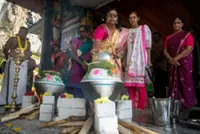Crafting intricate jewellery from brass is a time-consuming process, says Labunda. Photos: The Star/Low Lay Phon
When Jason Labunda was a young boy, he would listen with rapt attention as his grandmother told him Sabah folklore stories, such as The Dragon of Kinabalu, The Chinese Prince and the Kadazan Maiden and The Shipwrecked Prince.
He learnt about Sabah’s rich history, folklores, myths, legends that hark back centuries and his Kadazan grandmother, Bobohizan (high priestess) Tomunsi Matanul, enjoyed sharing these tales with Labunda before bedtime.
Already a subscriber? Log in
Save 30% OFF The Star Digital Access
Cancel anytime. Ad-free. Unlimited access with perks.





